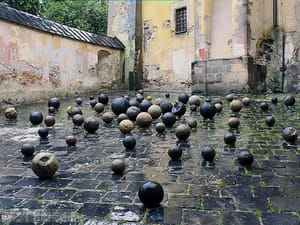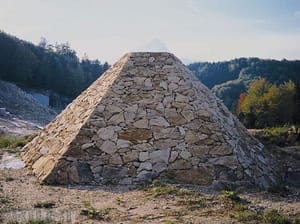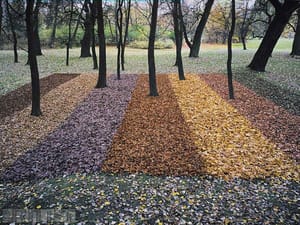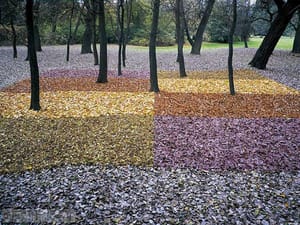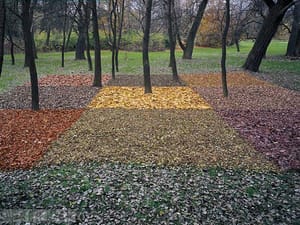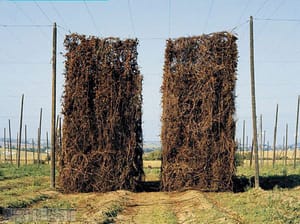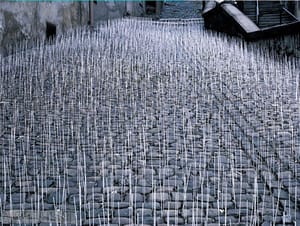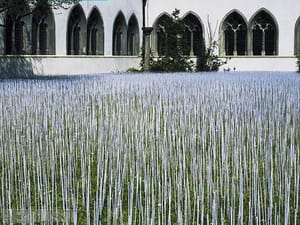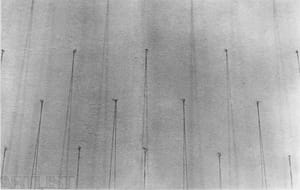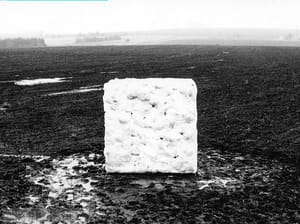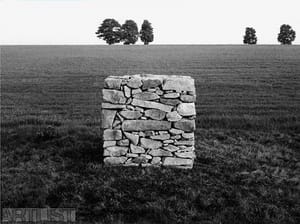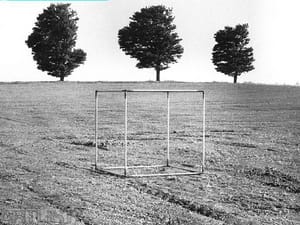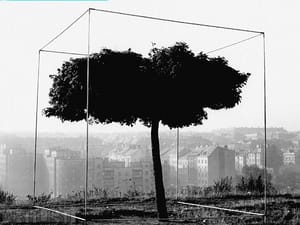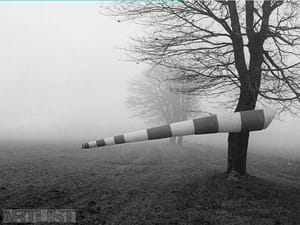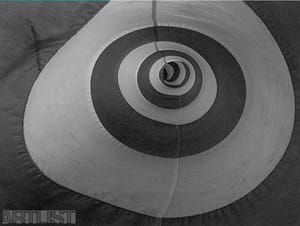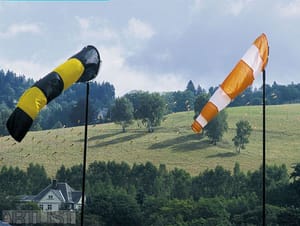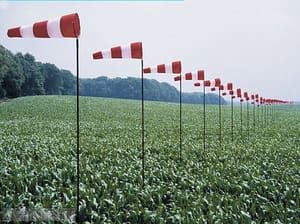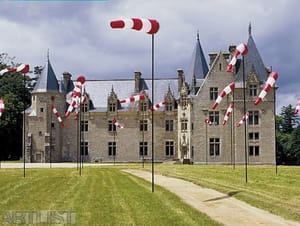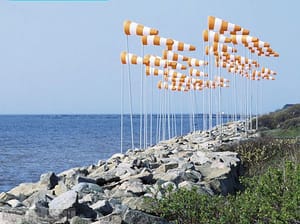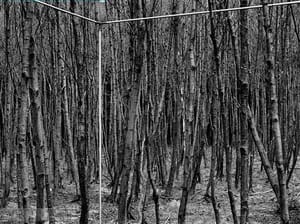- First Name
- Ivan
- Surname
- Kafka
- Born
- 1952
- Birth place
- Prague
- Place of work
- Prague
- i-datum
- ↳ Find in the VVP AVU database
- CSU Library
- ↳ Find in the catalogue
About artist
Seeks a new identity for artefacts, one that is static but yet has potential for movement at the same time, personalised minimalist resources, lyricism but yet a non-sentimental substance.
The ability to ask timely questions about contemporary society’s relationship to nature, on personal freedom and obligations to society, a strong feeling for the creativity of cultural and geographic differences. This is how we could generally characterise the creations of Ivan Kafka. For his type he is unique but still open to a wide spectrum of interpretation. He can engage the viewer with a simple, universally understandable language – without verbose packaging, encrypted symbols, or additional explanations. Of himself he has, for a long time now, had a fixed spot in the Czech and international creative (art) scenes.
Kafka tends mostly to express himself through big installations in the countryside. He uses them to take basically utilitarian objects and introduce them in new relationships to natural happenings (i.e. the long-term project, Room for Freedom (and also Despair) / Prostor volnosti (i skleslosti) – a modified compositional set of windsocks in various parts of Europe. He is also interested in exploring the possibilities of closed, architecturally-fixed, determined space (i.e. the interior set up of ping-pong balls, battle-axes, darts, or the arms on watches that run their cycle, but do not show the time, or installations hung at precisely-defined levels from pieces of white cotton, which is an artificial transfiguration of a cloudy sky, Darkened Light).
He similarly understands the challenge of municipal bodies (i.e. Boundaries (Limitations) on Jánský vršek in Prague / Vymezení na Jánském vršku v Praze, Joyous Alarm in London and Munich / Výstraha z radosti v Londyně a Mnichově). Kafka reassesses given space to provide it a new order and through this a new purpose. He uses multiple resources which themselves have their own potential and reflect a completely different function from their original ones.
Each Kafka work is integral in its sense of unity both general and private. It is however primarily the private role that directs Kafka’s creativity. In large public installations it is there for its potential and without superfluous proclamations. However, from time to time Kafka has a need to focus exclusively on it (creativity). This concerns an in-depth research on problems that demand greater attention and focused contemplation on the paradox of the relationship between natural and artificial, public and private. In these moments Kafka chooses to use a smaller format. These are a certain type of space commentary (sketches, Plexiglas cubes), which have the same meaning for him as do larger installations. Kafka’s realisations are based on a firmly-set concept, whose important component is a clearly-formulated idea. At times it may be expressed in the title, which also becomes a fundamental part of the artistic work. Similarly it has a minimalist aesthetic, preferring rather the traditional.
- Author of the annotation
- Hana Rousová
- Published
- 2007
CV
Studies:
1967-1971 Secondary Art School, Prague
Stipends:
1990 The Pollock-Krasner stipend, New York (New York)
Employment / activities:
since 1997 member of Akademie der Künste, Berlin
1990 Summer academy, Salzburg
since 1987 member of the art group 12:15, Pozdě, ale přece
1974-1976 works as a meteorologist
- Member of art groups included in ARTLIST.
Exhibitions
- Solo exhibitions
-
2006
Ivan Kafka: Související rozmanitosti 1981 - 2005 / 2000+6, AP galerie, Praha - Holešovice
Ivan Kafka, Od místa k místu, Galerie Šternberk, Šternberk
2004
Ona B. + Ivan Kafka, Galerie Navrátil, Praha, realizace: Čeští pytlíci
2003
Ivan Kafka, Národní chrčení do prázdna, Moravská galerie v Brně, nádvoří Uměleckoprůmyslového muzea, Brno. Realizace: Národní chrčení do prázdna
2002
Kulturbrücke Fratres, Fratres, Rakousko (H. Felbermair). Realizace: Zelená v zelené
Symposion Hofgut Hohenkarpfen, Hohenkarpfen, Německo. Realizace: Zvláštní houbařská sestava (Pfifferlinge)
2000
Festival Mitte Europa, Sachsen-Bayern-Böhmen, Kornerberg, Klingenthal / Hraničná, Německo / Česká republika. Realizace: Prostor volnosti VI
Ivan Kafka, Werkstatt Europa 2000, Positionen europäischer, Gegenwartskunst Forum Kunst Rottweil, Rottweil, Německo, katalog. Realizace: Neuchopitelná rovina
1998
Ivan Kafka / Prag, ifa- Galerie Berlin, Berlín, Německo, katalog
Fotografie a objekty, Galerie 4 – Galerie fotografie, Cheb
Evropský umělecký prostor II, Jiří Kolář. Ivan Kafka, Galerie Oskara Kokoschky, Praha, Rakouský kulturní institut v Praze (Prague)
1997
Ivan Kafka, Galerie výtvarného umění v Litoměřicích, katalog. Realizace: Chrčení do prázdna. Instalace: Stolek k obhlédnutí 1956 - 1997
La Biennale di Venezia 1997, XLVII Esposizione Internazionale d’Arte Padiglione della Repubblica Ceca, Giardini di Castello Benátky, Itálie, katalog
1996
Analysis and Commentary Central European Contemporary Art, Shiseido, The Ginza Art Space Tokyo, Japonsko, katalog (Péter Forgácz, Piotr Jaros)
Ivan Kafka, Galerie ‘60 /’70 Praha, katalog. Instalace: Letmý stolek 1956 - 1996
1995
Rej 1399 – 1995, Galerie Nová síň Praha, katalog. Realizace: Rej 1399 - 1995
Zdvojení 1291 / 1995, Galerie Klatovy – Klenová hrad Klenová, katalog. Realizace:
Zdvojení 1291 / 1995
1993
ZUR.ZEIT Ivan Kafka, Finsteres Licht, Kunst.Halle.Krems Minoritenkirche Krems, Rakousko, katalog. Realizace: Temné světlo
1992
Jeden projekt, Galerie im Kultur- und Informationszentrum der ČSFR, Berlín, DE
Kresby + instalace, Galerie hlavního města Prahy, Staroměstská radnice (2. patro), Praha, katalog, Realizace: Plno prázdna
1991
Kresby, instalace a realizace, Galerie Studio Opatov, Praha, katalog
1990
Kresby a realizace, Malá výstavní síň OKS, Liberec.Realizace: O opakovaném koloběhu a lidském hmoždění
1989
Fotografická dokumentace, Malá galerie Na hradbách, Kolín
1987
Instalace a dokumentace, Alvar Aalto-Museo, Jyväskylä, Finsko, katalog. Realizace: Společný Jyväskylský kopec na jezeře / Yhteinen Jyväskylän mäki järvellä
Kopce a hromady, Galerie Wschodnia, Lodž, Polsko, katalog.Realizace: Dva stavy možného snažení
1985
Dokumentace 76 – 85, Ústav makromolekulární chemie, Petřiny, Praha, katalog
1982
Galerie Hildebrand, Klagenfurt, Rakousko, katalog
Objekt, fotografie Horácké divadlo Jihlava
1979
Povídka o skládání, vlání, zvedání; Institut průmyslového designu Praha, katalog
Objekt, fotografie, serigrafie Salon fotografiky, Lodž, Polsko, katalog
- Group exhibitions not included in ARTLIST.
-
2012-2013
Ř! Česká národní identita v současném umění, Galerie Vysoké školy uměleckoprůmyslové (Galerie VŠUP), Praha 1 (Prague)
2011-2012
V plném spektru. Fotografie 1900-1950 ze sbírky Moravské galerie v Brně, Pražákův palác, Brno
2011
Pohled do archivu 2 - plakát, DOX, Malá věž, Praha (Prague)
2010-2011
Dialog 21, Galerie Califia, Horažďovice
2009
Sochy v ulicích / Brno Art Open '09, Brno (Brno-město), Brno
2008-2009
1960 → Súčasnosť/ Slovenské umění + čeští hosté., Dům U Zlatého prstenu, Praha (Prague)
2008
Kalendáře pro Jindru Štreita, Galerie Smečky, Praha (Prague)
Pohledy do sbírek Severočeské galerie výtvarného umění v Litoměřicích, Severočeská galerie výtvarného umění v Litoměřicích, Litoměřice
Nechci v kleci! / No cage for me!, Muzeum umění Olomouc, Olomouc
Ivan Kafka & Tomáš Svoboda, Centrum pro současné umění FUTURA, Praha 5 (Prague)
2007
Tschechische Aktionskunst der 1960er bis 1990er Jahre / České akční umění 60. - 90. let, Tschechisches Zentrum Berlin (České centrum Berlín), Berlín (Berlin)
Z mesta von - Umenie v prírode, Mirbachov palác, Bratislava
Die durchsichtige Welt, Landschloss Pirna - Zuschendorf, Pirna - Zuschendorf
Průzračný svět: Podoby vody / Durchsichtige Welt, Galerie moderního umění v Roudnici nad Labem, Roudnice nad Labem
2006
Od země přes kopec do nebe...: O chůzi, poutnictví a posvátné krajině, Zámek Klenová, Klenová
Kalendáře pro Jindru Štreita, Dům umění, přednáškový sál, Ostrava
2005
Místa paměti, Galerie Šternberk, Šternberk
Od země přes kopec do nebe...: O chůzi, poutnictví a posvátné krajině, Severočeská galerie výtvarného umění v Litoměřicích, Litoměřice
The New Ten, The Museum of Modern Art, Oostende
The New Ten, Kunsthalle Mannheim, Mannheim
2004
Za sklem. Ze sbírky Jaroslava Krbůška, Galerie Jiřího Jílka, Šumperk
Ejhle světlo / Look Light, Jízdárna Pražského hradu, Praha (Prague)
The New Ten, Vienna Künstlerhaus, Vídeň (Wien)
2003-2004
Ejhle světlo / Look Light, Moravská galerie v Brně, Brno
2003
Asociace a paralely, Galerie Caesar, Olomouc
Svět jako struktura, Struktura jako obraz, Galerie U Bílého jednorožce, Klatovy
Minisalon, Centre tchèque Paris (České centrum Paříž), Paříž (Paris)
2002
Česká a slovenská fotografie 80. a 90. let 20. století, Dom umenia, Bratislava
Power, Casino Luxembourg - Forum d'art contemporain, Luxembourg
Objekt - objekt: Metamorfózy v čase / Object - object: Metamorphoses in time, Pražákův palác, Brno
Minisalon, Museum Puri Lukisan, Ubud
Minisalon, Galeri Nasional Indonesia, Jakarta
Minisalon, Majapahit Mandarin Hotel, Surabaya
2001
Objekt - objekt: Metamorfózy v čase / Object - object: Metamorphoses in time, Dům U Černé Matky Boží, Praha (Prague)
Milano Europa 2000, La Triennale di Milano, Milano
2000
Dva konce století 1900 2000, Dům U Černé Matky Boží, Praha (Prague)
Art a Centreeuropa. 1949 - 1999, Fundació Joan Miró, Barcelona
1999-2000
Aspekte / Positionen. 50 Jahre Kunst aus Mitteleuropa 1949-1999, Vídeň (Wien)
1999
La nature, en dix chapitres / Die natur in zehn Kapiteln, Kanakakis municipal Gallery, Rethymnon
Die Natur in zehn Kapiteln / La nature, en dix chapitres, Badischer Kunstverein, Karlsruhe
1998
La nature, en dix chapitres / Die natur in zehn Kapiteln, Centre Rhénan d´Art Contemporain (CRAC), Altkirch
...o přírodě..., České muzeum výtvarných umění, výstavní prostory, Praha (Prague)
Nové tapiserie z Moravské gobelínové manufaktury, Mánes, Praha (Prague)
Minisalon, Bibliotheque Royal de Belgique, Brusel (Bruxelles)
1997
Kořeny / The Roots, Mánes, Praha (Prague)
Tapiserie, obraz, prostor, Galerie výtvarného umění v Hodoníně, Hodonín
La Biennale di Venezia 1997, Benátky (Venezia)
1996
Špét, ábr doch, Niederösterreichischen Landmuseum, Vídeň (Wien)
Slávnosť 25 kunstenaars uit Tsjechische en de Slowaakse Republiek, Venray, Venray
Opakované příběhy, Šternberský palác, Praha (Prague)
Opakované příběhy, Místodržitelský palác, Brno
Fineart ´96, Valdštejnská jízdárna, Praha (Prague)
1994-1995
Der Riss im Raum, Martin-Gropius-Bau, Berlín (Berlin)
1994
Distant Voices, South London Gallery, Londýn (London)
Volné seskupení 12/15 Pozdě, ale přece: U zdymadla, Mánes, Praha (Prague)
Volné seskupení 12/15 Pozdě, ale přece: Menší formáty, Galerie Via Art, Praha
Minisalon, Art and Culture Centre, Hollywood
Impermanent Places / Proměnlivá místa, The World Financial Center, New York (New York)
1993
Archetypy, Mánes, Praha (Prague)
Sympozium Prostor I. - Práce pro místo, Galerie Sýpka-Vlkov, Osová Bítýška
Minisalon, Musée des Beaux Arts, Mons (Belgie)
1992
Volné seskupení 12/15 Pozdě, ale přece: Kresby, Art Galerie, Žďár nad Sázavou
Prague - Bratislava, D´une géneration, l´autre, Musée d'Art Moderne de la Ville de Paris - ARC au Couvent des Cordeliers, Paříž (Paris)
1991
Kunst, Europa, Tschechoslowakei, Kunstverein Braunschweig, Braunschweig
Volné seskupení 12/15 Pozdě, ale přece: Český globus, Městská knihovna, 2. patro, Praha (Prague)
Šedá cihla 78/1991, Galerie U Bílého jednorožce, Klatovy
Kunst, Europa, Tschechoslowakei, Kunstverein Lingen Kunsthalle, Lingen
Aktuell 91. Junge Kunst aus Prag, Künstlerwerkstätten, Mnichov (München)
1990
Volné seskupení 12/15 Pozdě, ale přece: Kreslení, Galerie Fronta, Praha (Prague)
Neoficiální. Umění Československa 1968-1989, Místodržitelský palác, Brno
1988
Lubenec 88, Střediskové kulturní zařízení, Lubenec
Prešparty ´88. Stretnutie československých výtvarníkov, Múzeum SSR / Múzeum Slovenskej republiky rád, Prešov
První výstava Volného seskupení 12/15 v Kolodějské jízdárně, Jízdárna, Koloděje, Praha (Prague)
1987
Aktuální fotografie 2 - Okamžik, Alšova jihočeská galerie v Bechyni, Bechyň
1984
Záznam o činnosti, Galerie H, Kostelec nad Černými lesy
1983
Chmelnice, Mutějovice, Mutějovice
1982
Práce architektů, malířů a sochařů, Ústav makromolekulární chemie (ÚMCH), výstavní síň, Praha (Prague)
1981
Kresba / Grafika, Hvězda 1981 / Hájenka, Hájenka ve Hvězdě, Praha (Prague)
Sochy a objekty na malostranských dvorcích, Malá Strana, Praha
1979
Čtyři z Prahy, Galerie Wielka 19, Poznaň, Polsko
1978
Strom, Kabinet fotografie J. Funka, Brno
1977
Klub mládeže Křenová, Brno
Monography
- Monography
2012
Ivan Kafka: Míra snesitelnosti 2009-2012
- Other critical texts
▪ Janina Ojrzyńska: v: Ivan Kafka. Objekt, fotografie, serigrafie, Galerie LTF, Lodž 1979, katalog
▪ František Šmejkal: Návraty k přírodě, 1982. v: In memoriam Albert Kutal. Praha 1984
▪ Jindřich Chalupecký: The lessons of Prague, v: Studio International, vol. 196, NR. 1003,Londýn 1982
▪ Josef Hlaváček, František Šmejkal, Ivan Kafka, v: Ivan Kafka. Ústav makromolekulární chemie, Petřiny, Praha 1985, katalog
▪ Zdeňka Gabalová: Peripeties of Czechoslovakia’s Art, v: Dialogue / Prag / Los Angeles, Santa Monica Museum of Art, LA 1990, katalog
▪ Hana Rousová: Skeptisch. Eine Positionsbestimmung der aktuellen Kunst in Prag, v: Aktuell 91, Lothringer Strasse 13 Mnichov 1991, katalog
▪ Jana und Jiří Ševčík, Ivan Kafka, v: Kunst Europa. Kunstverein, Braunschweig, 1991, katalog
▪ Josef Hlaváček, Ivan Kafka, s. 68 - 73, 1982. Promluva, s. 101 - 103, 1986., v: Výpovědi umění, nakladatelství Ústí nad Labem 1991 /
▪ Josef Hlaváček, s. 61 - 65 / 256 - 260, v: Hlaváček, nakladatelství Artefact, Praha 1999
▪ Karel Srp: Některé realizace Ivana Kafky. v: Ivan Kafka. Galerie hlavního města Prahy, Praha 1992, katalog
▪ Hana Rousová: Temné světlo, Ivan Kafka, v: ZUR.ZEIT, Kunst.Halle.Krems 1993, katalog
▪ Josef Hlaváček: Nálehavost přítomnosti v díle Ivana Kafky, v: Výtvarné umění, s. 52 - 63, 5 - 6, 1993. Praha 1993
▪ Pavel Liška: Im Bann der Vergangenheit. Zur Lage der Kunst in Prag. v: neue bildende kunst, 2 / 1994, Berlín 1994
▪ Ludvík Hlaváček: Art as Message: Greetings from Prague v: 22. Bienal International de Sao Paulo 1994, katalog
▪ Jiří Švestka: Ivan Kafka. v: Der Riss im Raum, Martin-Gropius-Bau, Berlín 1994, katalog
▪ Jeff Crane: Ivan Kafka. Galerie Nová síň, v: Artforum, February 1996, New York 1996
▪ Josef Hlaváček: Příběhy (díla) I. K., v: Ivan Kafka. Galerie výtvarného umění
Litoměřice 1997, katalog
▪ Olga Malá: Ivan Kafka, v: La Biennale de Venezia 1997, XLVII Esposizione Internazionale d’Arte, Benátky 1997, katalog
▪ Alfred Nemeczek: Biennale 1997. Ein Lied vom Tod in Venedig, v: art, Das Kunstmagazin, NR 8, August 1997, Hamburg 1997, v: Kunstforum: Biennale Venedig. Bd. 138, September-November 1997, s. 454
▪ Simona Mehnert:, v: Ivan Kafka, Zwischen System und Intuition, Gestaltung in komplexen Zusammenhängen, ifa- Galerie, Berlín 1998, katalog
▪ Monika Leisch-Kiesl, Johanna Schwanberg : Ivan Kafka: „Ostrov“ volnosti (i skleslosti), v: Nexus, Künstlerische Interventionen im Stadtraum s. 122 - 129,
Springer-Verlag Wien New York, Vídeň 1999
▪ Regina Lange : Ivan Kafka / Tab. 88 / s.192, v: Das fünfte Element - Geld oder Kunst , Kunsthalle Düsseldorf 2000 (K)
▪ Ursula Zeller: Ivan Kafka, Neuchopitelná rovina, v: Werkstatt Europa, s. 70 - 85, Forum Kunst Rottweil 2000, katalog
▪ Olga Malá : v: Milano Europa 2000, s. 150 - 151, Electa, Milano 2001, katalog
▪ Karel Srp, :Prostory, místa, věci, v: Dějiny umění / 12 (José Pijoan). s. 56, Euromedia - Knižní klub a Balios. Praha 2002
▪ Jiří Valoch: Národní chrčení do prázdna, v: Ateliér, s. 4, 19 / 2003. Praha 2003
▪ Lenka Lindaurová,: Ivan Kafka - rozhovor, v: Art & Antiques, s. 52 - 63, červen 2006. Praha 2006





